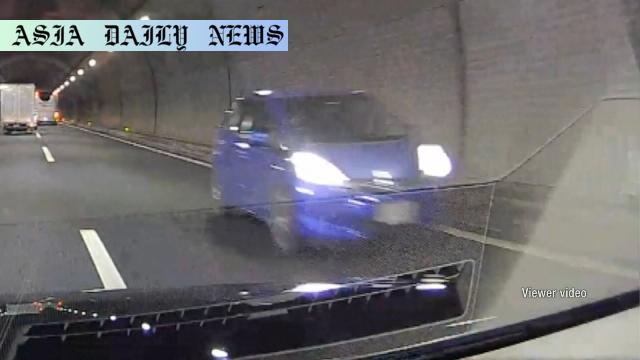Wrong-way driving incident caused chaos as a 34-year-old driver in Japan collided with vehicles, injuring four and fleeing the scene.
A motorist caused accidents by driving the wrong way on the Shin-Meishin Expressway.
The incident left four people injured, and the driver fled the scene.
Authorities later arrested the 34-year-old driver, who admitted to making a wrong turn.

Driver Causes Chaos on the Shin-Meishin Expressway
In a shocking event on the Shin-Meishin Expressway in Mie Prefecture, Japan, a 34-year-old Peruvian driver, Rossi Cruz John Elias, caused a major traffic upheaval after driving in the wrong direction. This incident unfolded on a Sunday when the motorist, reportedly heading west along the expressway, made an ill-fated U-turn, causing collisions and carnage in his wake. His actions led to a series of unfortunate road accidents, injuring four people and leaving law enforcement scrambling to piece together the events.
According to investigators, the driver “realized he took the wrong road” but decided to continue against the flow of traffic. This impulsive decision resulted in collisions with two vehicles directly. Furthermore, the chaos caused additional pile-ups as other drivers attempted to swerve to safety. What made matters worse was the driver’s decision to flee the scene, shirking responsibility and further complicating the scenario on the crowded expressway.
Details of the Arrest
Authorities apprehended the suspect the following Monday, bringing some semblance of order to the disarray caused by his reckless behavior. Police revealed that the suspect was heading to Yokkaichi City in Mie Prefecture with his cousin riding as a passenger. Initial investigations suggest that the suspect had obtained his Japanese driver’s license over five years ago by converting a foreign license acquired from his home country. This detail has raised questions regarding current processes for license conversion and whether stricter evaluations are necessary to avoid such incidents.
The reckless driving on the Shin-Meishin Expressway underscores how critical it is for drivers to exercise prudence and responsibility on the roads. Efforts are now underway to evaluate the injured parties’ health and investigate the exact sequence of events, along with determining why the suspect made the U-turn in the first place.
Implications of Wrong-Way Driving
The incident also brings to light a pressing issue that persists globally: wrong-way driving on highways and expressways. This phenomenon, frequently linked to errors in judgement, is especially catastrophic because it heightens the probability of head-on collisions—one of the deadliest types of road accidents. In this particular incident, while it is fortunate that the injuries were not fatal, the potential for a far graver ending was considerable.
Legal experts in Japan anticipate severe penalties for the driver, including charges of reckless endangerment, fleeing the scene of an accident, and potentially driving under distress conditions. Public sentiment has also echoed strong condemnation of such acts, with calls for stricter penalties for such violations to discourage future occurrences.
Global Concerns Around Driver Awareness and Safety
Driving incidents like these accentuate the significance of driver awareness and adhering to road signage. Globally, countries face challenges ensuring that drivers remain vigilant and informed of local road rules, especially for foreign drivers or those unfamiliar with regional systems. Easier access to tools such as GPS and refined license conversion systems may play a role in preventing similar missteps.
The increasing reliance on advanced road systems and mapping tools also places some responsibility on drivers to stay attentive and avoid making mistakes that can have disastrous consequences. Such incidents are tragic reminders of how misjudgments and lapses in responsibility can cascade into widespread accidents on the roadways, necessitating a discussion on ways to prevent them effectively.



Commentary
The Need for Stricter Road Safety Measures
The recent wrong-way driving incident in Japan highlights the ever-present challenges on the world’s roads and necessitates a thoughtful discussion on how road safety can be improved. While it is easy to criticize the driver for his recklessness, it is equally important to delve deeper into the probable causes that may have led to such a poor decision.
Having a robust system for cross-border license conversion is one way to reduce risks like these. Drivers must not only navigate different types of roadways, but they must also understand regional nuances or driving rules. In cases like this, more emphasis on localized road education during license conversion could potentially prevent mistakes.
Addressing Human Errors on Roads
As much as modern technology, such as GPS, assists in navigation, human error continues to play a considerable role in accidents. Instances like these should push experts, lawmakers, and law enforcement agencies to prioritize the exploration of innovative solutions to minimize wrong-way driving events. Enhanced signposting, the installation of additional barricades, or even sensors to detect wrong-way driving could significantly contribute to safeguarding public lives.
Drivers themselves, however, must bear responsibility for their choices. Road signs are clear, and attempting a U-turn on an expressway is a decision that defies both logic and caution. Greater awareness campaigns and public education focusing on safe road etiquette would also supplement efforts to minimize infractions like these.
Concluding Thoughts
This incident serves not only as a stark reminder of the consequences of carelessness but also as a call to action for improving road safety for all. While penalties for offenders are essential, a proactive approach focused on fostering a safer driving culture can be equally transformative. Governments, city planners, and motorists should work in harmony to ensure roads are as safe as possible for everyone on them.